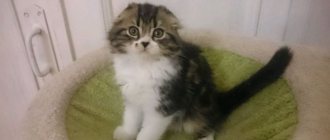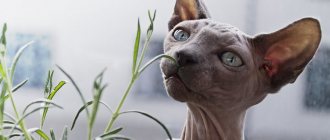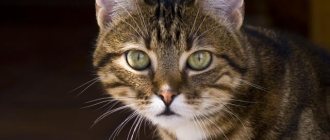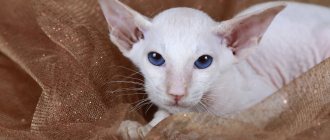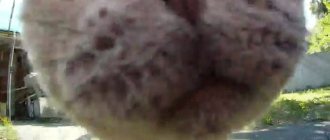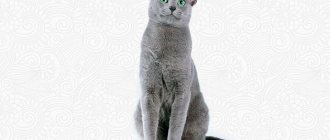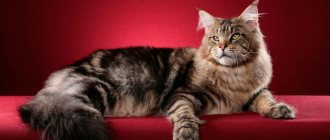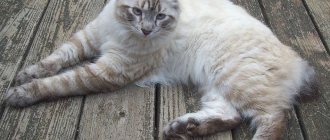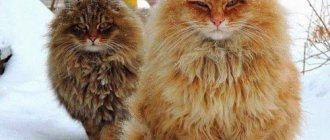To find out for sure whether your kitten is a representative of the Maine Coon breed, to assess its prospects as a sire and to predict the chances of receiving regalia and titles at exhibitions, you need to know the breed standards.
There are different associations of cat lovers and breeders, each of them develops its own judging rules for a particular breed. These standards are basically similar to each other, but still have differences.
For the Maine Coon breed, the most current standards at the moment were created by the WCF (World Cats Federation), FIFe (Federation International) and TICA (The International Cat Association) systems. Despite a lot of nuances, they all paint the same image of a “correct” Maine Coon cat. A detailed study of the standards helps to clearly imagine the appearance of a thoroughbred “coon”.
Color
The color has an incredible variety of shades, they are classified as follows:
- tabby - stripes of different colors on a background of different shades;
- solid – monochromatic color, available in white, cream, black, blue and red shades;
- smoky – smoky, comes in various shades: black, blue, chinchilla, silver;
- calico - distinguished by rare large spots on a white background;
- tortoiseshell - characterized by random multi-colored spots throughout the body.
There is an opinion that the character of these cats depends on their color, for example, black cats are flexible, tortoiseshell cats are restless, tabby cats are independent. Therefore, you can choose a kitten that is most suitable in color and characteristics.
Standard colors
The standard eye shades for cats are:
- Green. Allowed in cats with a predominance of black, blue, lilac color, coat of cinnamon, fawn, chinchilla color.
- Yellow. Characteristic of tabby cats.
- Copper. Allowed for cats with black, chocolate, lilac, blue, red, cream color.
- Icy and light blue. Acceptable for all white cats.
However, white cats with blue eyes are often deaf in both ears. Among white pets with one blue eye (heterochromia), unilateral deafness (on the side of the blue eye) is observed.
History of the origin of the breed
The Maine Coon breed appeared in most regions of our country relatively recently, just over twenty years ago. It was then that the so-called “Iron Curtain” collapsed and almost immediately a whole stream of new breeds of cats and dogs poured in, including a couple of Maine Coons.
According to legend, in ancient times there lived Captain Kun, who was very fond of large long-haired cats, but some of them ran away from the deck during the next voyage, which made it possible for the breed to appear in many countries.
According to the generally accepted or official version, the first Maine Coon cat was shown at the Boston exhibition, but then the breed was undeservedly forgotten. Only thanks to English farmers it was possible to preserve the main breed characteristics of the American raccoon cat. Almost a quarter of a century ago, on the territory of the English Isle of Man, a coin was issued that was dedicated to the legendary Maine Coon breed.
Choosing a kitten, care, education
It is first recommended to obtain basic knowledge about cats, visit exhibitions and nurseries. Study the description of the Maine Coon breed, listen to reviews from breeders. Classes of kittens of the same litter:
- shows - exhibitions;
- breeding - breeding;
- pet - for home (cannot be bred).
If the mating is registered, the kitten must have a pedigree; class does not matter. The baby is taken from the mother at the age of 12 weeks.
Choice
Give preference to a large, active animal. The kitten must have:
- sparkling eyes,
- sparkling fur,
- "box"
- ear tassels,
- long ponytail.
Pay attention to the mother cat, she should look well-groomed and healthy
Care
The kitten will need:
- 2 bowls (for food, water), it is better to choose earthenware or ceramic dishes;
- toilet, filler;
- scratching post;
- bed;
- toys;
- game complex.
Place the bowls together (on the kitchen floor), preferably on a tray. Place the tray in a secluded place, optimally in the bathroom. Clean the toilet at least once a day. Block loopholes into secluded places (under a sofa, closet, etc.). When cleaning up feces left in the wrong places, use an odor neutralizer.
The bed should be located where no one will disturb the kitten. However, he himself will choose where it is better for him to sleep. Play complexes are sold in pet stores. You can adapt homemade horizontal platforms installed at different heights.
Upbringing
Aimed at preventing the development of bad habits. It is necessary for the kitten to be accustomed to:
- to the toilet,
- rules of conduct,
- procedures of combing, bathing and others.
Teach care procedures after play, when the baby gets tired and relaxes. At first it will be an imitation of cutting, combing, and examining. Gradually increase the time of tactile contact. Always give your kitten a treat at the end.
It is recommended to accustom your coon to a hair dryer:
- Turn on the hair dryer when the kitten is eating, and gradually move the device closer to it.
- Keep the device nearby, the air stream should not hit the muzzle.
- Direct a stream of cool air at your pet (for a few seconds).
- Day by day, increase the duration of exposure to the hair dryer.
It is important to immediately establish a good relationship with the coon; you should not perceive him as a living toy. It is strictly forbidden to poke your nose, hit you, or use other aggressive methods.
Education should be based on the principle of “strict but fair.” To stop your cat from scratching furniture, jumping on tables, and pooping in inappropriate places, use a spray bottle of water.
Toilet training
Toilet training doesn't take long. Keep an eye on the kitten after feeding, and if it becomes restless, put it on the potty. Don't let go until it's empty. The excrement must be removed immediately. Maine Coons are known for their cleanliness; if the toilet is dirty, the pet can “visit” another place.
When do kittens' eyes change color?
This depends largely on the heredity and breed of the kitten. In outbred cats, eyes, as a rule, begin to change at the age of 1–1.5 months. In purebreds, this process can begin between 1 and 12 months of age. The final eye color is established by the age of two.
Blue-eyed cats have very little melanin in the iris. Certain genes are also responsible for its quantity. However, this trait is recessive, so such cats are very rare.
The more pigment in the eyes, the darker the color of the cat's eyes.
Absolutely all kittens' eye color becomes brighter by the age of one month. This is due to the fact that after the eyes open at 10–12 days of age, they are covered with a film. Because of this, the shade appears grayish. By 3–4 weeks, the film disappears, making the color of the eyes brighter.
This process has given rise to many myths on the Internet:
- All kittens have bright blue eyes. In fact, they can be bright blue, light and dark blue, gray-blue in various shades.
- Eye color directly depends on color. This statement is true only for purebred cats, in which a certain trait has been fixed through long selection, and for color-point cats. But in fact, the eye color can be absolutely any with absolutely any color.
- Eye color depends on diet. This has not been confirmed in any way by science or felinologists. It is only known that the color of a cat’s coat can change with a certain diet (for example, color-point colors darken from frequent feeding with fish).
Color-point cats have fur that is darkened by fish.
Breed selection
Choosing the right breed will allow you to get a pet with the best characteristics in the future. You can distinguish a purebred Maine Coon kitten by the following features:
The breed involves the birth of kittens with a larger weight than ordinary ones. Average weight is 130 g. Already at three months the baby weighs from 2 to 2.5 kg. The coat is initially thicker, and the body is strong and massive.
Pedigree kittens have a thick tail and powerful paws. By the age of three months, kittens have tassels on their triangular ears. But of course, the main guarantee is the pet’s pedigree, confirming its purity and quality.
Nutrition
When purchasing a small Maine Coon, it is better to feed him his usual food for a while. Then you can introduce the kitten to other foods.
A complete diet for a small Maine Coon should contain up to 40% protein, 15-30% fat, 2.5% fiber, and the rest should be carbohydrates.
When feeding kittens, it is important to follow a diet. The main diet is raw lean meat. These are beef, chicken, rabbit, and offal. To strengthen joints, you need chicken scallops, beef tendons, and pig ears. Meat should be frozen for at least three days.
The source of minerals will be raw chicken necks, heads, backs, paws, and tails. They must be ground or given whole. Raw yolk is very useful for kittens.
When purchasing a small Maine Coon, it is better to feed him his usual food for a while
Fish should be given with caution and infrequently. Kittens drink milk for up to two months, and then their body loses the ability to digest lactose. It is replaced with fermented milk products, cottage cheese, and hard cheese.
Sometimes kittens happily eat raw grated vegetables and fruits and herbs. Adding a small amount of olive oil will help. There must be clean water available at all times.
It is not recommended to feed kittens food from the human table: it contains too many different additives that are harmful to the animal’s digestion.
Natural nutrition table for Maine Coon kittens by month
The nutritional norms and diet for Maine Coon kittens are presented in the table:
| Age in months | Daily value in grams | Number of feedings per day | Diet |
| Up to a month | Around the clock | Mother cat's milk | |
| 1,5-2 | 150-190 | 6 | Milk, liquid porridge, pureed meat |
| 2-3 | 180-240 | 4 | Raw lean meat, liver, some sea fish, vegetables, fruits, egg yolk, kefir, yogurt, a little olive oil. |
| 3-6 | 180-220 | 4 | Offal, chicken feet, heads, backs are added |
| 6-9 | 200-250 | 3 | Same diet |
| 10-12 | 180-220 | 2 | Same diet |
Feeding kittens with prepared food
High-quality industrial cat food contains all the necessary nutrients. Some manufacturers produce special food for Maine Coons: Bosch Sanabel Kitten, Royal Canin, Hills.
Be sure to read:
What to feed a Maine Coon kitten: recommendations, diet from a month to a year, what not to give
The amount of dry food is calculated individually and depends on the size of the kitten. First, the granules should be diluted with store-bought milk. Adults can be given canned food.
Industrial feeds are stored for a long time and are convenient to use. The packages usually indicate the serving size and other recommendations.
Weight of cats and cats by month
The final weight of a Maine Coon becomes clear after the first year of life. He may gain quite a bit over the next few years, and this will be due to muscle development. Males and female cats usually stop gaining weight at 5 years of age; further excess weight may be associated with nutritional disorders. Males are noticeably larger than cats, and these differences can be seen without even looking under the tail.
- A newborn cat weighs 120-160 g, a female cat weighs 100-140 g.
- The weight in the first two weeks for a cat is 190-250 g, for a female cat – 160-230 g.
- From the third week, the weight of the male and female can almost double: 440-600 g and 420-550 g, respectively.
- By the first month of life, boys gain 630-750 g, and girls - 560-680 g.
- From the second month, kittens receive the first kilogram: 1.2-1.5 kg for males, 1.1-1.4 kg for females.
- At three months, the weight of the male reaches 2.8-3.6 kg, the female - 1.7-2.4 kg.
- After the third month, kittens begin to develop rapidly and gain more than a kilogram with proper nutrition. The weight of boys can be 3-3.8 kg, and girls - 2.7-3.6 kg.
- Less significant increase in weight by the fifth month. 3.2-4.2 kg for males and 2.8-3.9 kg for females.
- After the kittens overcome the most difficult time - the first six months - their weight will be 3.8-4.5 kg and 3.2-4 kg, respectively.
- At 7 months, kittens will increase in weight by about half a kilo. So, a male can weigh 4.2-5.6 kg, and a female 3.6-4.7 kg.
- Similar changes will occur by the eighth month. Kittens of both sexes will gain approximately 500 g and their weight will be 4.5-6.1 kg and 3.8-4.9 kg.
- At 9 months, males will weigh 4.6-6.8 kg, females - 4.1 kg-5.8 kg.
- By 10 months, cats of both sexes will still gain weight: 4.8-7.2 kg and 4.3-6.5 kg, respectively.
- By the 11th month, the indicators change slightly. Males weigh 5-7.5 kg, and kitties weigh 4.3-7 kg.
- At one year, the kitten becomes an adult and takes on the weight category that corresponds to its physiological characteristics. Subsequent changes will be insignificant and will be the result of his lifestyle and diet. By the age of one year, males reach a weight of 8.8-5.4 kg, and females 4.5-8.3 kg.
What influences development
The development of a purebred pet is influenced by the following factors:
- Floor; girls are usually born smaller in size than male maikunas; Adult cats are also different; they weigh less.
- Number of babies in the litter; most often 4-5 individuals are born. If a cat has 6-7 kittens, each weighs about 100-120 g;
- Parameters of the mother and her nutrition during pregnancy. Food rich in proteins, fats, vitamins and beneficial microelements will support the cat’s health and provide the baby’s body with the necessary substances;
- Conditions of detention; a clean, healthy, vaccinated and treated animal for ticks, fleas and worms is stronger than its unkempt counterparts;
- Selection work of the breeder; affects the formation of the skeleton and skull of the pet.
- Stressful condition in a cat. The composition of mother's milk in an unfavorable situation deteriorates, this affects the growth of babies.
Character of the breed
The Maine Coon's personality is responsible for the breed's current rise in popularity. Animals of this breed provide excellent company to the owner, without being too annoying, and although he can be “talkative”.
Behavior is sometimes more canine than feline due to the need for companionship and affection. They tend to be attached to people, but they are also happy to spend time alone, sleeping or exploring the surrounding area.
Your cat can be left at home for a standard 8 hour workday, just make sure she has food, water, a place to stretch her legs, scratch her nails and take a safe nap.
Maine Coons are affectionate cats that love attention. For example, sit on the owner’s lap, play with him, but they will be happy just being in close proximity
To a large extent, these cats are tolerant of the attention of children, which makes them an excellent assistant for parents, but you still need to be careful as the cat is large.
Why do newborn kittens have blue eyes and how eye color changes
To understand exactly how the change in eye color in kittens works, you need to start with the very development of the kitten in the womb. Already at the initial stages, 34 pigment centers are localized in the embryo, from which the pigment, during the growth and development of the kitten, moves mostly to the hair follicles and accumulates there. There is negligible amount of it in the iris.
The most interesting thing is that the pigment continues to accumulate after birth, which is why the color of the kittens’ eyes changes.
But why do all newborns have blue, gray-blue or blue eyes? It's all about the amount of pigment (melanin) - it is known that the less pigment, the lighter and cooler the eye shade. At the time of birth there is little of it in the iris. This is the reason why all babies have cool blue or light blue eyes.
There is no pigment in the eyes of newborn kittens, so they have blue eyes.
Actually, what final eye color a kitten will have is determined by a set of genes inherited from the parents to the baby. It is responsible for the amount and presence of pigment in the eyes and the speed of its movement there. This is what determines when the eye color changes and what it will be like.
The cat's iris is divided into two layers: the upper one is the stroma and the lower one is the epithelium. It is the amount of melanin in the stroma that is responsible for eye color. If there is a lot of it, then the color will be brown or copper, if less - green, if very little - blue or cyan.
With a probability of at least 50% you can predict what eye color a kitten will have if you look at its parents
Maine Coon Health
The Maine Coon cat breed is naturally healthy, but there are some peculiarities.
Maine Coon diseases
Maine Coons have dysplasia of the heads of the hip joints. Due to the weakness of the heads, the joint is easy to twist. Proper nutrition helps prevent the development of the disease.
Spinal muscular atrophy is much more dangerous. It causes muscle wasting and weakness. But, fortunately, this disease is now rare.
If you have any health problems, you should consult your veterinarian as soon as possible, as they may indicate the onset of a dangerous disease.
Infections most often occur by eating sick rodents or contaminated meat. Cats can become infected with tuleria from rodents, which begins with fever and apathy, and swollen lymph nodes. A sick animal quickly loses weight, ulcers appear and pneumonia develops.
Hemorrhagic fever begins with high fever, chills and vomiting. Bleeding can be either from the nose or internal, so the disease is very dangerous.
Insufficiently cooked beef can lead to bovine tuberculosis and even deadly spongiform encephalitis. In the latter case, neither boiling, nor freezing the meat, nor drying it will help. Therefore, you should buy meat and dry food from manufacturers who do not skimp on a thorough analysis of the product and the components used in its production.
Additional characteristics of the Maine Coon breed
Additional external signs of a true Maine Coon include tufts on the ears, the presence of hair between the toes and a luxurious tail. If a kitten's tassels have not grown at 2-3 months of age, they will no longer exist. But this does not discard him from breeding and does not close the way to diplomas at exhibitions.
Friendliness and sociability
An adult Maine Coon is truly responsive, friendly and attached to its owner. But this is not a unique sign that indicates the “purity” of the breed.
Love for water
Unlike ordinary cats, Maine Coons love water. They swim without being forced and at the same time snort contentedly, which shows their owner their pleasure. If a pet is afraid of water, it probably has a mixture of other breeds in its genes.
FIFe (Europe)
The FIFe system, founded in the first half of the 20th century, is today the main one for many clubs. Representatives of different breeds can take part in exhibitions, and the regulations were developed exclusively for internal users. The current Maine Coon breed standard has several differences from other systems:
- Big size.
- The space between the ears increases as the cat ages.
- Clear eye color is desirable, but not required.
- Males have a strong neck with well-developed muscles.
- The color allows any amount of white fur.
- The type of cat is more important than the color of the coat.
The disadvantages of the breed specified in FIFe coincide with those described in the standards of other systems.
What does it look like
The climatic conditions of Maine, where the breed originated, had a significant impact on the appearance of these cats: in cold and snowy winters, cats could survive only thanks to their thick undercoat and massive physique. Wide, fluffy paws are also a “print” of the influence of climate, because thanks to this device the cat does not fall under the snow, but can slide along it. As for the size of the cat, this is its main advantage, which allows it to obtain food in the form of small animals without much difficulty. Of course, over time, the breed has undergone some transformations: the Maine Coons that we know now show weight gain, a more elongated face, and larger ears than their ancestors.
The sculpted head has an elongated, massive shape, with high cheekbones and a small nose. Such deformation is caused by natural need: the wild ancestors of the breed often looked for prey in burrows, sticking their noses into them, which became the prerequisites for the sharpening of forms. The head flows smoothly into a strong and muscular neck, which is decorated with a lush collar of wool. The most valuable for breeders are those with a collar that reaches the length of the ear flaps.
Wide-set eyes are round in shape and slightly squinting. Eye color, as a rule, includes various shades of yellow and green, which looks very harmonious in combination with the color.
The ears are large in size, slightly tilted forward, and have a wide base. The previously mentioned “lynx tassels” are the hallmark of the Maine Coon. Large, wide ears provide cats with good hearing, making them excellent at catching mice. At one time, it was with this advantage that fluffies conquered American farmers. The skin of the ears is thick and protected by a thick layer of hair; the cartilage has a dense structure. Cats know how to press their ears to their head, as if folding them - this provides them with protection from the cold wind.
The muscles are strong and well developed. The skeleton is large, wide; the back is straight. Strong limbs allow the cat to jump impressive distances. And massive, rounded fingers make the landing as soft and safe as possible.
The length of the Maine Coon's tail is equal to the length of its body. The tail is wide at the base and has no kinks. A dense and thick coat provides cats with protection from the winter cold: in extreme conditions, the tail curled around the body helps them not to lose body temperature. The length of the coat, as a rule, varies from 10 to 15 centimeters, has a heterogeneous structure, longer on the stomach and shorter on the back. The thickest fur is located on the thighs (the so-called “pants”). The back is mainly covered with guard hairs, the coat is more rigid. But the belly and sides are protected by an undercoat that resembles down.
Color
Maine Coons all over the world can vary significantly not only in color, but also in size. In the last decade, the show career has flourished for cats of almost all colors except lilac, brown and blue. But the recognized and popular colors are shades of black, white marble, and agouti.
Some Maine Coons, however, have defects and do not have the right to represent the show class, losing the opportunity to participate in exhibitions. Among these defects are:
- incorrect distribution of undercoat over the body area, relatively short hair on the “collar”;
- if the tail is shorter than the length of the cat’s body;
- if the animal is small in size;
- when blotches or spots are visible on the fur;
- the presence of humps or depressions on the nose;
- wide placement of ears;
- presence of extra toes.
By the way, the latter phenomenon, called polydactyly, has become widespread among Maine Coons, and is now a strict ban on the exhibition career of cats.
CFA
According to the general description, Maine Coons are strong cats with great endurance and are adapted to life in difficult climatic conditions. These are well-balanced and harmoniously built animals, without signs of excess. The main feature of the breed is its smooth and shiny coat. When assessing a particular specimen, type, not size, is of paramount importance.
Description of the standard:
- Head. It has medium length and width, a square-shaped muzzle. A wider head does not cause fines or disqualification of the animal, if we are talking about stud cats.
- Ears. Large, with pointed tips and tassels on them. Set wide and high, the distance between them approximately coincides with the width of the ear at the base.
- Eyes. Large, slightly convex, set wide and slightly oblique. They can be green, gold, golden-green or copper. Blue eyes are allowed only in representatives of the breed with a white coat or bicolors.
- Body. Medium or large, rectangular, well-developed muscles. The neck is of medium length, the chest is wide.
- Limbs. Strong, medium length, proportional to the body. The pads are round and there are tufts of fur between the toes. The front paws have 5 toes, the hind paws have 4.
- Tail. Long, tapering towards the end, covered with long hair.
- Coat. Fluffy, long, silky. Shorter on the shoulders than on the belly and hind legs.
- Coat color. White, black, blue, red, cream colors, various variations of tabby and tipping colors are allowed.
Reasons for disqualification:
- Light frame.
- Wedge-shaped or narrow muzzle.
- Malocclusion.
- Strabismus.
- Noticeable use of cats of other bloods when breeding an animal.
Chocolate, lilac, cinnamon or Siamese coats are not acceptable.
Care instructions
If a mixed breed is nevertheless purchased, the first thing you need to do is show it to a professional veterinarian, determine the vaccination schedule and sterilization date, and also identify the individual’s defects.
If everything is relatively fine with the kitten, then the care recommendations are practically no different from keeping purebred cats, namely:
- daily combing with a furminator during the period of active molting;
- Using shampoo and conditioner for long-haired cats while bathing;
- a diet of raw beef, boiled chicken and rabbit than purchased food;
- milk is prohibited;
- sour cream, kefir and cottage cheese are useful;
- premium jelly food is allowed, but there is a chance that the cat will then refuse natural food;
- It is recommended to wash your eyes daily with a special composition to avoid infection;
- The animal must have special toys freely available to remove plaque;
- weekly cleaning of the ears with cotton pads soaked in a special lotion;
- weekly manicure (the first procedure is recommended to be carried out by a specialist, who will also show how to do it correctly without touching the blood vessels);
- if the mixed breed is large, a large tray is needed.
It is necessary to buy any purebred purebred cat or cat when it reaches the age of 3.5 months - it is at this age that almost all defects are discovered, and purebred Maine Coon cats grow tufts on their ears. The pedigree of a real Maine Coon should indicate 4 generations of his ancestors and their exhibition achievements, and also remember that purebred cats are never sold at discounts (a culled individual is usually only one in a litter and costs 2–3 times less, and not by 10%).
To learn how to determine the purebred of a Maine Coon, watch the video below.
Maine Coon and an ordinary cat have many differences, however, the market is filled with a huge number of kittens that are passed off as real purebreds. In fact, at best it will turn out to be a mestizo - a cross between a Maine Coon and an ordinary cat, or it will even turn out that the Maine Coon was not even close to that.
In order not to make a mistake in choosing, you need to clearly know the characteristics characteristic of this breed. Before you go for the long-awaited kitten, it is worth studying in advance how the Maine Coon and an ordinary cat differ.
The handsome Maine Coons, with their appearance and large size, are more reminiscent of a real wild animal than a pet, due to which the demand for representatives of the breed has been steadily growing in the last decade.
At what age does the iris change color?
It is impossible to say exactly when the temporary eye shade will change to the final one, programmed at the genetic level, since the duration of this process is not least influenced by heredity and breed. In outbred animals, a change in the color of the iris is usually observed at 1–1.5 months of age. In their purebred counterparts, this process can be extended over time and begin at either 1 month or 1 year.
All cubs, without exception, have a brighter iris color at one month of age than it was initially. This is due to the fact that only the opening eyes (kittens are born completely blind and begin to see only on the 10th–12th day of life) are covered with a film. As a result, their color appears dull. By the third or fourth week it disappears, the eye color becomes richer. This moment has given rise to many misconceptions. For example, it is generally accepted that the eye color of these animals is:
- When born it is bright blue. This is not true because they come in bright blue, light blue, dark blue, and gray blue.
- Directly depends on the color. This relationship can be traced only in purebred animals in which a certain trait is fixed, as well as color-point cats. In fact, the eye color can be absolutely any, regardless of the shade of the coat.
- Depends on nutrition. This opinion has not been confirmed. It is only known that some foods can change the color of their coat (for example, color-point coats darken due to frequent consumption of fish).
Distinctive character traits
The character of Maine Coons is usually balanced and flexible. They are friendly, love communication and usually spend most of their time in the company of people. They also love to be played with, but they can also simply lie down next to their owner, emitting a cheerful purr. In addition, they are very photogenic and love to be photographed.
Another feature of this breed is that they get along well with other pets: cats and dogs. But you should be very careful with hamsters and parrots. These cats have a well-developed hunter instinct, so it is better not to provoke them. Many owners note that these cats are very smart and can even be trained. They can be taught to fetch small objects, for example, light toys, balls. It all depends on the patience of the owner.
Why do cat eyes change color?
Most members of the cat family have irises ranging from greenish-yellow to golden. In some animals it has a different shade. For example, Siamese cats have blue eyes even in adulthood.
Those with white spots on their coats are also sometimes blue-eyed. The snow-white markings are explained by a special gene that also affects the shade of the eyes. Individuals with a snow-white coat have blue eyes.
Kitten with heterochromia
Sometimes the “white spot gene” leads to a deficiency of pigment in only one organ of vision, while the other retains normal pigmentation. This is how animals with different colored eyes are born. This feature is called heterochromia. It also happens in pure white individuals. Thus, the popularity of Angora cats is also due to the fact that they are often born with heterochromia.
The world's largest Maine Coon
Few people know that the largest Maine Coon cat in the world, named Omar, lives in the British city of Melbourne. The animal's body weight is 14 kilograms, and its length is as much as 120 centimeters, which breaks all previous records, as reported by The Telegraph. The publication writes that the cat’s favorite treat is raw kangaroo meat.
The fact that the Maine Coon is the largest cat in the world has been known for a long time. The previous recorded record for the length of a cat's body - 118 cm - also belongs to a cat of this breed. However, Omara's owner decided to compete for championship in this category, sending her pet's measurements to a special commission in the hope that he would defeat his rival and receive the coveted title of the largest cat in the world.
Price of kittens
Having learned about the record holder, many dream of getting a pet of impressive size and are interested in: how much does a Maine Coon cat cost, is such a “purchase” affordable?
There are rumors that cats of this breed are bred by entrepreneurs in order to make large profits from their sale. It should be noted that organizing such a business requires, firstly, large investments, and secondly, it is unlikely that people who know nothing about breeding purebred Maine Coons would simply risk their funds. Without spiritual aspiration and professional knowledge, such a business would not have lasted long, much less won the respect of breeders around the world.
Maine Coon cats have ancient roots, and in order to pass on the gene for their native “wild” color and aristocratic manners, breeders need to seriously try.
In addition, specialists in their field are constantly working to breed subtypes of the breed of the most unusual and original colors, showing extraordinary creative and professional abilities.
Let's find out how much a Maine Coon kitten costs and what its cost depends on. Several important factors influence price formation:
- breed qualities of appearance and character;
- purebred, confirmed by good pedigree;
- gender of the kitten;
- dimensions and color of the animal;
- merits of the cat's parents;
- funds spent on feeding and veterinary care for the mother cat and newborn kitten;
- location (naturally, in Moscow and St. Petersburg, for example, cats will cost slightly more than in Siberia, the Urals and other regions remote from the capital);
- kitten delivery service (if you order an animal in a remote city, you will pay more than if you brought it yourself).
As you can see, it is impossible to say exactly how much the Maine Coon breed costs.
In any case, Maine Coons are not cheap; you need to be prepared for this immediately when choosing a kitten. If we talk about purebred babies from nurseries with a good pedigree, then they cost an average of 35-40 thousand rubles. Individual representatives of the breed with the original color or descendants of the best lines can cost much more.
Babies “from amateurs” cost an average of 10-15 thousand rubles. Usually, these are kittens without documents that appeared as a result of mating according to the type: you have a cat, I have a cat, and let’s breed. When selling, they often say that they didn’t do the paperwork on purpose, they say, there’s a lot of hassle, but potential buyers (far from all the details of the breeding business) are happy: kittens are cheaper, and they don’t need paperwork, because they take a kitten for the soul. In fact, kittens without documents are not representatives of a particular breed and in the circles of professional felinologists are considered outbred.
Mixed-breed kittens are usually sold inexpensively - up to 5,000 rubles. The price depends on external data, similarity to Maine Coons, as well as the integrity of the breeders.
TICA (America)
The second largest felinological organization in the world, founded in 1079, its main office is in the USA. Exhibition activities comply with American rules and require open judging and the judge not having any information about the animal and its titles.
TICA unites not clubs, but Maine Coon breeders and owners, and the judges of this organization must regularly confirm their qualifications.
TICA standard:
- Head. Wide, in the shape of a modified wedge, the forehead is rounded, the cheekbones are prominent.
- Ears. Large, with a wide base, medium pointed, set high relative to the head, the auricle is slightly inclined outward.
- Eyes . Large, set wide. Their color has nothing to do with the color of their coat.
- Color. Any color is acceptable, as well as a white outline around the chin, eyes and lips.
- Coat. Serves as protection from weather conditions; there is a small undercoat, the quality of which should be different from the outer coat.
A Maine Coon can be fined for:
- Eyes wide open.
- Small size.
- Rounded head shape.
- Short tail.
- Long limbs.
- The coat is the same length.
- Specks, spots.
- Sparse undercoat.
- Almond-shaped eyes.
- Ears located close to each other.
- Short tail.
Reasons for disqualification:
- Aggressive behavior, attempts to bite or scratch the judge.
- Cryptorchidism.
- Lack of tail, its creases.
- Strabismus, blindness.
- Extra fingers or xiphoid process.
- Size inappropriate for breed.
It is strictly prohibited to use representatives of other breeds in Maine Coon breeding.
Breeding Features
Breeding Maine Coon mestizos is strictly prohibited; the seller must inform the buyer that the animal is a half-breed. However, buyers themselves should also not let down their guard and not buy kittens at discounts.
If you cross a male Maine Coon with a female of smaller cat breeds, the mother will most likely die during childbirth due to the kittens being too large.
In terms of friendliness and sociability, mestizos are categorical in nature: a kitten can be either too friendly and even somewhat annoying, or aggressive. Unscrupulous breeders, as well as inexperienced fanciers, for example, seeing that the kitten looks like a Bengal and not a Maine Coon, and are dissatisfied with the appearance, can simply throw the animal out into the street, dooming it to hunger and wandering. Therefore, they often try to sell kittens as early as possible, while it is difficult to distinguish them from purebred ones.
It is often better to buy a purebred Siberian cat than a mixed breed. Purebred felines are much better in health and character than a mixture.
Maine Coon kittens
The kittens are quite large, with a rectangular body. The babies have large paws, fluffy fur, a clearly visible collar and lynx tassels on their ears. They have an expressive and intelligent look. Until the age of one year, kittens may look awkward, but as they go through the stages of growing up, babies turn into balanced, beautiful cats. Maine Coons reach full maturity by the age of 4.
Maine Coon kittens are playful and sometimes destructive, active, and always busy with something. Once in a new home, they behave confidently, explore every corner and very quickly find contact with all the inhabitants of the house, adapting to the new living conditions. Maine Coon kittens are usually rehomed at 12 weeks of age or older.
Maine Coon kittens are difficult to distinguish from mestizo, since mestizo is endowed with many features of a purebred individual.
- But mestizos are inferior in size to purebred Maine Coons; they are not so large.
- Purebred Maine Coons mature within 4 years, while mixed breeds reach full puberty by 2-3 years.
- The Maine Coon has a noticeable collar and fluffy coat even after molting. Mestizos may not have a pronounced collar, and may be less shaggy.
Comparative table of the rating scale in points
| Category | CFA | TICA | FIFe | WCF |
| Head | 30 | 40 | 40 | 30 |
| Head shape | 15 | 8 | ||
| Eyes | 5 | 5 | ||
| Ears | 10 | 10 | ||
| Eye shape and fit | 5 | |||
| Ear shape and placement | 10 | |||
| Body | 30 | 35 | 35 | 35 |
| Frame | 15 | 10 | ||
| Limbs | 5 | 3 | ||
| Neck | 5 | |||
| Tail | 5 | 5 | ||
| Backbone | 7 | |||
| Musculature | 10 | |||
| Coat, color, pattern, eye color | 35 | 25 | 20 | 30 |
| Wool | 20 | 25 | 20 | |
| Balance | 5 | |||
| Condition | 5 | 5 |
Maine Coon: history of the breed
The Maine Coon cat breed originated in Northeast America, in Maine, USA. The ancestor of the breed is considered to be a cat named Captain-Jenks-of-the-naval-cavalry
He attracted widespread attention at cat shows held in 1861 in New York and Boston.
At that time, the fashion for Maine Coons did not arise, but these large and strong cats took root among local farmers - they were highly valued for their hunting skills.
Maine Coons thrive in cold climates
Literally translated, the name of the breed sounds like “Maine raccoon” and to this day in North America, Maine Coons are known as the Maine raccoon cat. There is even a version that these animals originated from the connection between raccoons and cats. But much more consistent is the opinion that representatives of this breed originated from the mating of tabby cats with North American lynx.
According to scientific research, Maine Coons are an aboriginal breed; the characteristic genotype of their breed developed naturally, under the influence of the harsh climate of North America. In the second half of the 20th century, due to its characteristics, cats of this breed began to gain popularity in North America and Europe. Representatives of the Maine Coon breed were brought to the territory of the western republics of the former USSR in 1992.
By now, Maine Coon Cats are popular all over the world. Their breeding is a multimillion-dollar business, part of which is the popularization of the breed through various exhibitions and advertising in the media.
Maine coon cat in all its glory
Maine Coon health and life expectancy
Maine Coons can “boast” not only of their outstanding size, but also of good health. They practically do not get sick, since they have good immunity from birth. A Maine Coon cat can live 15–20 years.
To rule out urolithiasis, you need to take your pet to the veterinarian once every six months. To prevent this problem, the Maine Coon must eat properly and receive the necessary care.
Proper nutrition and proper care of the animal will help prevent the onset of urolithiasis, which is typical for Maine Coons.
The animal may have joint problems. However, a kitten leaves the nursery for a new family usually at the age of 12 weeks. At this time, joint pathologies are immediately visible. To avoid problems with the health of the animal, it is better to take it from those breeders whose reputation is impeccable.
A Maine Coon has been living in my friend's family for 3 years. During this time, the cat has not had any illnesses, he is cheerful, cheerful and eats well.
Advantages and disadvantages of a crossbreed
A mixed breed born from a Maine Coon has advantages, but more disadvantages.
Disadvantages of a mixed-breed cat:
- high probability of having genetic abnormalities that appear in the first generation;
- aggressive and uncontrollable behavior after reaching puberty;
- partial presence or complete absence of breed characteristics of appearance;
- exclusion from participation in competitions;
- lack of documents indicating pedigree;
- the impossibility of crossing with an ordinary cat, since the process of giving birth to large cubs can end in the death of the female.
Advantages of mestizos:
- good health;
- lower cost;
- the opportunity to participate in competitions for outbred pets.
Communication with the owners
Maine Coons are affectionate towards their household, but completely indifferent to guests. Only after some time, having gotten used to the new person, will the kun begin to show him signs of attention. The Maine Coon will distance himself with dignity from the squeezing and squeezing of random people, in his opinion. This indicates the intelligibility in communication characteristic of representatives of this breed.
Maine Coons have an unusual way of communicating with people - they rarely meow, and the purring they make resembles the melodic chirping of a bird.
When choosing a Maine Coon as a companion, a cat lover should know that an unusual pet will appear in his home, one that does not quite correspond to traditional ideas of what a cat should be. He will not be an introvert immersed in his own world, rarely condescending to the owner - on the contrary, coons need live communication.
They can give a lot to the person nearby, but they themselves need reciprocal attention. The Maine Coon's character is as unique as its appearance. Cats of this breed will not assert themselves by hissing and releasing their claws - they are patient and supportive of people.
Eye color standards
Each breed has a personal accepted standard for eye color. These are quite strict rules that should not be broken.
So, which breeds have strict restrictions on eye color:
- Abyssinian cat. This breed can only have green or yellow eyes.
- Burmese cat. This beauty's eyes can only be light gold.
- Burmilla. Green of any intensity.
- Balinese. Blue or blue eyes.
- Bombay cat. Only deep copper eye color.
- Burmese cat. Exceptionally bright blue eye color.
- Havana brown. Green or yellowish-green.
- Egyptian Mau. The eyes are light green (gooseberry color).
- Korat. Amber or amber-green eyes.
- Kao-mani. Yellow or blue eyes.
- Lykoy. Yellow or amber eyes.
- Nibelung. Only gooseberry eye color.
- Oriental cat. Green eye color is preferred.
- Ojos azules. Only blue eyes.
- Pixie bob. The eyes are gooseberry-colored, brown or yellow.
- Russian blue cat. Exceptionally green eyes, from light to rich emerald.
- Ragdoll. Only blue eyes.
- Siamese cat. Blue or blue eyes.
- Tonkinese cat. Aquamarine, blue or yellow eye color.
- Thai cat. Only deep blue eye color.
- Turkish van. Only gold or blue.
- Chausie. Yellow, copper, hazel or green eye color.
- Chartreuse (Carthusian cat). Copper, orange or amber eyes only.
The standard of some cat breeds allows them to have only a certain eye color (pictured are Havana Brown cats)
In some breeds, eye color may depend on coat color:
- British cats of the black solid, blue solid, cinnamon, fawn, and lilac colors cannot be green-eyed or blue-eyed.
- British Chinchillas and British Goldens can only have green eyes.
- White Turkish Angoras can only be blue-eyed, green-eyed, or yellow-eyed.
- In Oriental cats, yellow and blue are allowed in solid (solid) colors and blue in color-point colors.
Some interesting facts about eye color in cats:
- A Sokoke cat can change eye color depending on its mood.
- Very often, blue-eyed cats (especially white ones) are deaf.
- All cat lovers know that the blue-eyed gene in purring cats is recessive. However, in cats of the Ojos Azules breed, this gene somehow mutated into a dominant one. They can also be green-eyed or yellow-eyed. Also, deafness is not associated with the Ojos blue-eyed gene and they cannot be bred with other blue-eyed cats.
- All color-point cats can only be blue-eyed or blue-eyed. Their eyes absorb all colors of the rainbow spectrum except blue. They reflect it and therefore appear blue-eyed. But the brightness of blue depends on the amount of pigment: the more pigment there is, the paler the color of the cat’s eyes. In very rare cases, Color Points may have yellow eyes.
- If a cat has no pigment in her eyes, she will be red-eyed. This only occurs with albinism.
- Albinos can also have blue eyes (this is called partial albinism).
- As surprising as it may sound, outbred cats usually have much richer eye color than many purebred cats.
Abyssinian cats most often have green eyes
Maine Coon and other pets
The Maine Coon gets along with other cats, although it tries to dominate them. Thanks to his large size and weight, he manages to gain the position of leader, but sometimes fights occur in the struggle for authority. When kept with dogs, he prefers to remain neutral, but never becomes subordinate.
Another interesting quality helps the Maine Coon get along with other cats. He is very loyal to other people's kittens and even expresses his readiness to care for them.
Small skirmishes that periodically occur between a large cat and other pets or owners rarely develop into open hostility and overshadow the maintenance.
In general, the Maine Coon is a sociable cat with a good character. Still, appearances are deceptive - upon closer acquaintance, her inner world does not at all correspond to her predatory appearance, stern gaze and wariness.
I like it I don't like it
Education and training
In terms of intelligence or learning ability, Coons can compete with some dog breeds. They are easy to train and show loyalty to their owner. To train an animal, you need to put in effort and time. You cannot physically force, much less beat or punish an animal.
Playing and petting Maine Coons are easy to get along with.


